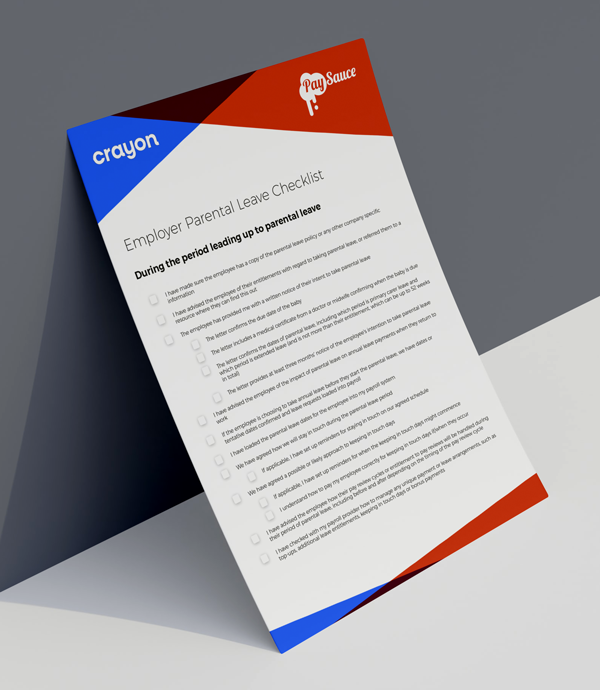Parental Leave
When Your Employees Are Expecting
This is a guest collaboration series with our friend Stephanie Pow from Crayon - she's building the first home for money and parenthood in New Zealand, helping parents navigate the unique financial puzzles they face so they can be the parents they want to be.
Often, an employee's parental leave experience comes down to their direct manager.
This means it can be very hit or miss - some managers go all-out, while others take an “out of sight, out of mind” approach. Instituting employer-wide processes ensures all expecting parents receive at least a minimum standard of treatment and care.
Provide employees with parental leave information
Walk them through their entitlements in a way that is easy to understand. It might be printouts, emails, in person, phone calls or any other way of communicating. It’s often easier to split this up and not push all the information at them at once - there’s already a lot going on in their mind, and it is complicated information to digest!
In addition, organisations are increasingly creating materials and procedures to guide managers through the parental leave process. At a minimum, this ensures the organisation is meeting the legal standard and when done well, it can enhance all employee’s experience.
If you feel you don’t understand the entitlements well enough to explain it clearly, then direct your employee to some resources available from government agencies, businesses or support services, such as SmartStart and Crayon.
Beyond advice on entitlements, it is also a great idea to have some easily accessible resources for information for expectant parents should they need support. Again, here’s some to get you started:
Check in regularly
Ask how they are feeling physically and mentally during their pregnancy while at work. There’s no need to pry, but you want to make sure from a health and safety perspective you’re doing all you reasonably can as an employer to ensure their ongoing wellbeing, especially as the pregnancy progresses. They might benefit from adjustments, such as more regular small breaks, the ability to sit more often if they are required to be standing a lot, or even the chance just to move around from their desk if they are sitting all day.
Flexible working to accommodate pregnancy
Blood tests, scans, medical appointments - the number of things a pregnancy person needs to do stacks up quickly. Under the law, employees who are pregnant can take up to 10 days’ unpaid special leave for pregnancy-related reasons. In practice, we see managers allow pregnant employees to work around these commitments if the nature of the role permits it, so that they don’t have to take unpaid time off.
Establish expectations or methods of communication for parental leave
Preferences can vary widely from parent to parent. The best way to know what your employee wants is to ask them. Both of you should aim to be clear on:
How, why and when you’ll communicate. How often? By email, phone or video call? Just when they initiate contact, or on a regular basis?
What you’re both thinking about keeping in touch days, with the understanding that plans might change once the baby has arrived - and that’s okay.
Their comfort level with public spectacles such as baby showers at work, or how they feel about their baby photos being shared within the office.
If they want invitations to company events, parties, meetings or trainings - or if they’d rather not feel pressured to attend.
If they have certifications that would need renewing (sometimes including training, fee payments, etc) during their period of parental leave, how will this be managed?
If there are going to be changes to the seating plan or desk arrangements while they’re away, and if anything would look different when they come back.
If there is anything else in particular they would like to remain informed about or discuss while on parental leave.
Establish expectations for remuneration
As we highlighted in Part 1: Common Mistakes, often expecting employees are left out of pay reviews, which is one of the reasons the gender pay gap persists. Have an explicit conversation about how salary, short-term incentives, stock option plans and any other key components of remuneration will be affected by parental leave.
Connect the expecting employee to a parental leave buddy
Welcoming a child is life-changing and expecting parents often lean on those around them for support and advice. Other parents at the same organisation can be a fountain of knowledge - from recommended daycare centres close to work through to how to manage pumping in the workplace.
Let the expecting employee know how dependents can be added to employer health insurance
Health insurance schemes are becoming a more common employee benefit, and usually employees can choose to add dependents (at their own cost or their employer’s depending on the arrangement). Often, dependents need to be added to the policy within 90 days to be eligible for pre-existing condition cover - but health insurance is the last thing on most people’s minds in the first 90 days after their baby is born. Check your policy, and encourage your employees to check in with the scheme provider or adviser administering the scheme. Ask if they’d like a reminder when the 90 days is coming up. Additionally, many of the insurance advisors who assist companies with managing these schemes can give employees advice (usually for free) if they want to know about other things like life or income protection insurance, so let your employee know how they can contact them if they need.
Baby showers and gifts to expectant parents
We love to see companies celebrating life events for their employees and this in particular is an exciting one. Think creatively about gifts, if it's something your company does: it doesn’t have to be a baby bath or a onesie. Gift vouchers, vouchers for meals or meal subscriptions, donations to charities on behalf of the parents - there are so many ways to celebrate the milestone in a way that suits the parents. You’ll know best what works to your budget and the employee’s likely needs or wants, but our advice here is just to think outside the box!
In times of crisis
It is also valuable to make extra resources available preemptively in case any of your employees ever need it - it is so much better to have it ready to hand or easily available if needed rather than needing to find it in a time of crisis.
Miscarriage and stillbirth support
Sadly, the loss of a child before or during birth can and does occur. Having information available in a safe space somewhere could really help your employee in the event this sad event comes to pass.
Family violence
Pregnancy and early infancy can be high risk times for those facing intimate partner violence. Remember to stay familiar with employee entitlements around family violence leave, but also, make resources available for employees to have the opportunity to seek help if they need it. Offering the right information to staff could be life-changing.
Keep your employees privacy and trust in mind at all times in a crisis situation. Leave entries might need to be recorded in payroll - perhaps enter it for them on this occasion rather than asking them to make the request, or consider asking your payroll provider for support for how to record these leave types confidentially. Ensure that the wishes of the employee are respected with regards to how information is shared or not shared - and that can, on occasion, include people with payroll or administrative access so seek advice as necessary.
 Stephanie Pow
Founder & CEO - Crayon
Stephanie Pow
Founder & CEO - Crayon
 Jessica McLean
CPO - PaySauce
Jessica McLean
CPO - PaySauce


